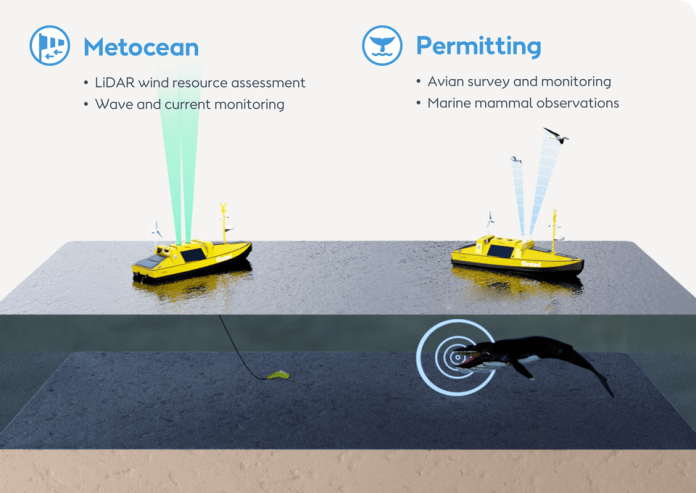Reading Time: 3 minutes
Ørsted, a global leader in offshore wind farms, unveiled the industry’s first uncrewed surface vessel (USV) designed specifically for offshore met-ocean measurement campaigns. This innovative technology, patented by Ørsted, will reduce the uncertainties in annual energy production projections for new offshore wind projects. Ørsted is now moving towards serial production, recognizing the significant potential of the USV concept.
The Hugin USV, Ørsted’s prototype uncrewed surface vessel, is specifically engineered to withstand extreme offshore conditions for up to a year. Equipped with a built-in navigation system, the USV is capable of autonomous or remote-controlled transit from shore. It offers line-of-sight and beyond-line-of-sight operations.
It has been designed as a generic sensor platform, capable of gathering extensive data on various parameters such as wind conditions, seabed conditions, and biological and ecological measurements. The USV’s ability to collect a wide range of measurements can help Ørsted’s preliminary development activities when planning and constructing new offshore wind farms.
The USV concept, invented by Ørsted employees, has received patent protection. Ørsted’s innovation program, conducted along with industry partners, facilitated the design, development, construction, and testing of the prototype USV. The Danish shipbuilder Tuco Marine Group constructed the prototype, while Norwegian company Maritime Robotics AS delivered the USV control system.
Ørsted’s approach of teaming up with small and innovative companies has been instrumental in the successful development of the USV prototype. It has allowed the company to leverage specialist expertise and also use Ørsted’s deep understanding of offshore measurement operations to deliver a USV prototype to the market quickly.
Frederik Søndergaard Hansen, Programme Manager and co-inventor of the USV concept said, “What’s so special about our USV concept is that it can bring our measurement equipment to and from our offshore sites without the need for large, specialised support vessels, and, while on site, it can operate autonomously for extended periods of time, measuring large amounts of data that can be sent onshore and processed in real time. The USV concept enables Ørsted to obtain a consistently high data availability, which is essential for achieving the highest possible certainty regarding the annual energy production for new offshore wind farms. Ørsted’s USV concept has several advantages over conventional solutions that rely on specialised support vessels to bring measurement equipment to offshore sites. The Ørsted USV improves safety by removing the risk for offshore technicians, reduces the overall carbon emissions significantly, and increases the operational window as it can operate safely in high sea state conditions.”
The USV concept offers a host of benefits to Ørsted, including significantly reduced costs for offshore measurement campaigns and increased operational flexibility through internal ownership and operation of the USVs. The prototype vessel, Hugin USV, has undergone extensive testing in Danish and Norwegian waters, including challenging hurricane conditions with waves up to nine meters in the North Sea. The Hugin USV has also achieved type validation as a floating LiDAR system by the internationally accredited Norwegian classification society ‘Det Norske Veritas’ (DNV), which allows the USV to be used for commercial operations related to wind farm development.
”The autonomous vessel is a very good example of Ørsted’s innovation methodology. First, we study the megatrends addressing our industry – in this case, the challenge of obtaining quality wind measurements and environmental data in the fastest time possible. Then, we apply our three-step demonstrator, stepstone, and commercial scale product-to-market recipe. Meaning, we start small and proof the concept, then through strong partnership collaboration, financial backing, and against the tide of macroeconomic trends, we persevere through our extensive inhouse project management experience and systematic problem-solving mindset,” said Jacob Edmonds, Head of Innovation at Ørsted.
Owing to the success of the prototype USV, Ørsted has initiated the serial production of a new class of USVs. These next-generation USVs have been designed to incorporate the valuable insights gained from the prototype and expand their operational capabilities to include deep-water operations for future floating wind farms. The construction of the USVs in the new class takes place in Denmark, with Tuco Marine Group responsible for the manufacturing process. The control systems are supplied by Maritime Robotics. Ørsted aims to produce five new USVs by the end of 2023.
















